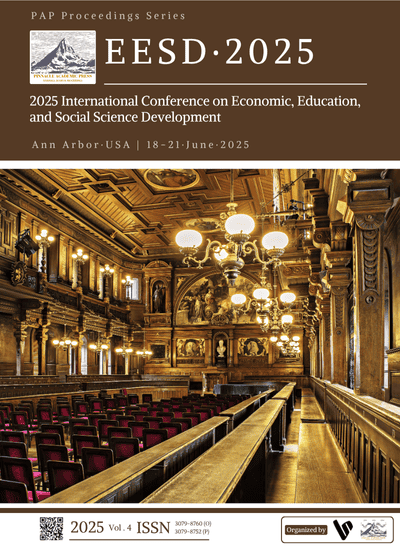"I'm Forever Chinese": The Role of ICTs in Cultural Identity Maintenance among Chinese Immigrants in Transnational Families
DOI:
https://doi.org/10.71222/xmcpt029Keywords:
Chinese immigrants, ICTs, cultural identity, transnational families, digital access disparitiesAbstract
This study explores the role of Information and Communication Technologies (ICTs) in preserving cultural and ethnic identities among Chinese immigrants in the U.S. By focusing on the case study of Haley, a second-generation immigrant, the research investigates how digital platforms like WeChat, TikTok, and YouTube facilitate the preservation of cultural heritage and promote cultural inclusion. ICTs enable real-time communication with family, participation in cultural practices, and access to traditional resources, helping bridge generational and cultural gaps. The study highlights how these platforms support dual cultural environments, balancing cultural roots with adaptation to American society. Additionally, challenges such as digital access disparities and the marginalization of older generations are discussed. The findings emphasize the transformative impact of ICTs on identity formation and provide insights into the ongoing negotiation of cultural and ethnic identity in transnational contexts. This research contributes to the broader discourse on globalization, cultural continuity, and the evolving role of technology in shaping immigrant identities.
References
1. U.S. Census Bureau, "American Community Survey: Selected population profiles," 2022. [Online]. Available: https://www.census.gov/newsroom/facts-for-features/2024/asian-american-pacific-islander.html. [Accessed: Jul. 30, 2025].
2. R. Johri, "Stuck in the middle or clued up on both? Language and identity among Korean, Dutch and Samoan immigrants in Dunedin," Ph.D. dissertation, Univ. Otago, 1998.
3. S. Montrul, "Current issues in heritage language acquisition," Annu. Rev. Appl. Linguist., vol. 30, pp. 3-23, 2010, doi: 10.1017/S0267190510000103.
4. F. Grosjean, A journey in languages and cultures: The life of a bicultural bilingual. Oxford University Press, USA, 2019.ISBN: 9780198754947.
5. G. Bacigalupe and S. Lambe, "Virtualizing intimacy: Information communication technologies and transnational families in therapy," Family Process, vol. 50, no. 1, pp. 12-26, 2011, doi: 10.1111/j.1545-5300.2010.01343.x
6. P. Levitt and N. G. Schiller, "Conceptualizing simultaneity: A transnational social field perspective on society," Int. Migr. Rev., vol. 38, no. 3, pp. 1002-1039, 2004, doi: 10.1111/j.1747-7379.2004.tb00227.x
7. A. Chib, S. Malik, R. G. Aricat, and S. Z. Kadir, "Migrant mothering and mobile phones: Negotiations of transnational identi-ty," Mobile Media & Communication, vol. 2, no. 1, pp. 73-93, 2014, doi: 10.1177/2050157913506007.
8. L. M. Anderson, D. L. Wood, and C. D. Sherbourne, "Maternal acculturation and childhood immunization levels among chil-dren in Latino families in Los Angeles," American Journal of Public Health, vol. 87, no. 12, pp. 2018-2021, 1997, doi: 10.2105/AJPH.87.12.2018.
9. J. Dicken, C. Martin, D. Mitchell, F. Pannekoek, and P. Bernard, "The internet as a site of citizenship," Can. J. Commun., vol. 27, no. 4, pp. 509-534, 2002, doi: 10.22230/cjc.2002v27n4a1324.
10. R. Darvin, "Design, resistance and the performance of identity on TikTok," Discourse, Context & Media, vol. 46, p. 100591, 2022, doi: 10.1016/j.dcm.2022.100591.
11. J. Lingel, M. Naaman, and D. M. Boyd, "City, self, network: transnational migrants and online identity work," in Proc. 17th ACM Conf. Comput. Supported Coop. Work Soc. Comput. (CSCW), Feb. 2014, pp. 1502-1510, doi: 10.1145/2531602.2531693.
12. J. Cheshire, "Who we are and where we're going: Language and identities in the new," in Beyond Boundaries: Language and Identity in Contemporary Europe, vol. 122, 2002. ISBN: 1853595551.
13. B. Kurniawan, "Dynamics of Chineseness on TikTok: Chinese Indonesian Identity through Surabayan TikTokers," in Proc. Creative Collaborative Commun. Conf. (CCOMM), vol. 1, no. 1, Oct. 2023, pp. 49-64.
14. B. Y. Perera, S. R. Chaudhury, P. A. Albinsson, and L. Nafees, "This is who I am: Instagram as counterspace for shared gendered ethnic identity expressions," J. Assoc. Consum. Res., vol. 6, no. 2, pp. 274-285, 2021.
15. C. Han, "Identity construction in weibo communication," Contemp. Chin. Discourse Soc. Pract. China, vol. 4, p. 143, 2015, doi: 10.1075/scld.4.09han.
16. I. Ang, On not speaking Chinese: Living between Asia and the West. Routledge, 2005. ISBN: 0-203-99649-6.
17. L. Hall-Lew, "Chinese social practice and San Franciscan authenticity," in Indexing Authenticity: Sociolinguistic Perspectives, 2014, pp. 55-77. ISBN: 9783110347012.
18. Y. Shi, "Identity construction of the Chinese diaspora, ethnic media use, community formation, and the possibility of social activism," Continuum, vol. 19, no. 1, pp. 55-72, 2005, doi: 10.1080/1030431052000336298.
19. D. Ip, "Simultaneity and liminality: identity anxieties of 1.5 generation Chinese migrants in Australia," in Transmigration and the New Chinese: Theories and Practices from the New Zealand Experience. Hong Kong: Univ. Hong Kong, 2011, pp. 163-182.
20. P. Parvin, "Integration and identity in an international context: Problems and ambiguities in the new politics of multicultural-ism," Political Stud. Rev., vol. 7, no. 3, pp. 351-363, 2009, doi: 10.1111/j.1478-9302.2009.00187.x.
21. K. Hanafi and R. W. Novchi, "New media and social identity of Malay ethnic," in Proc. 1st Int. Conf. Soc. Politics Humanit., Oct. 2020, p. 231.
22. X. L. Curdt-Christiansen and A. Hancock, Eds., Learning Chinese in diasporic communities: Many pathways to being Chinese, vol. 12. John Benjamins Publishing Company, 2014, doi: 10.1075/aals.12.contrib.
23. S. Hall, "Cultural Identity and Diaspora," in Colonial Discourse and Post-Colonial Theory, Routledge, 2015, pp. 392-403. ISBN:9781315656496.
Downloads
Published
Issue
Section
License
Copyright (c) 2025 Wenjun Zhu (Author)

This work is licensed under a Creative Commons Attribution 4.0 International License.



